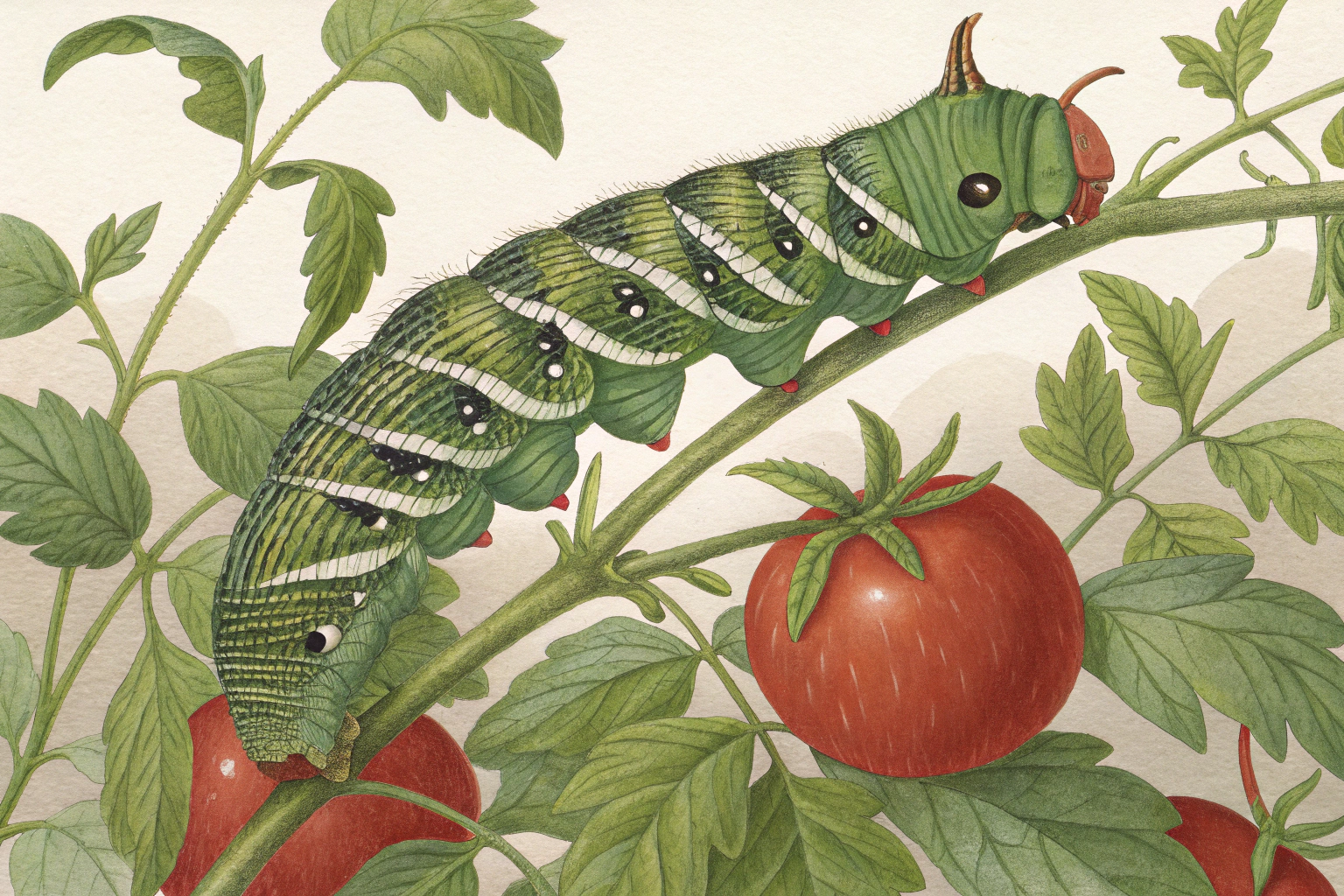Tomato Hornworm: How to Spot and Defend Your Summer Harvest

Tomato hornworm
The tomato hornworm strips leaves from tomatoes fast—spot their bold green bodies early, and handpick them before they skeletonize your plants. Follow the trail of black droppings to catch a tomato hornworm hiding along stems or under foliage. Look for chewed holes and missing leaves as the first sign you have a tomato hornworm problem.
These caterpillars feed with absolute abandon, but with quick action and sharp eyes, you can stop the feast in its tracks. Let’s untangle how to spot, manage, and even use nature to your advantage against this garden glutton.
Cheatsheet: Rapid Removal and Control for Hornworms
🕵️♂️ Signs of Infestation
- Large green caterpillars (up to 4 in/10 cm)
- Missing leaves or stems stripped bare
- Dark frass (droppings) on leaves and soil
- Peak activity: June to August
🧰 Tools and products you’ll need
- Garden gloves
- Bucket with soapy water
- Hand pruner (for heavy infestations)
- Organic insecticidal spray (Bacillus thuringiensis - Bt)
- Flashlight (for dusk inspections)
🥄 Step-by-Step Control
- Inspect daily in early morning or evening. Look for large larvae on leaf undersides and along stems.
- Handpick hornworms. Drop into soapy water bucket.
- Prune affected stems if leaf loss is severe.
- Apply Bt only if hand removal fails or infestation repeats.
- Check for white cocoons on worms: parasitized hornworms. Leave these as beneficial wasps are at work.
🐞 Natural Controls
- Attract lady beetles, lacewings, parasitic wasps
- Plant marigolds and basil nearby for deterrence
- Cultivate soil in early spring to destroy overwintered pupae
🍅 Nutrition & Self-Sufficiency
Unchecked hornworms can slash yield by up to 80%. Hand removal protects up to 10 lbs (4.5 kg) fruit per plant per season. Maintain supply for sauces, salads, canning.
⚡ Fast Facts
- One hornworm defoliates a tomato plant in days
- Moths emerge when night temps stay above 60°F (15°C)
- Hornworms lack toxins; removal is non-hazardous
The Tomato Hornworm: A Beautiful Menace
Nothing wipes the smug smile from a gardener’s face faster than tomato hornworm frass covering prized tomato foliage overnight. I’ve walked into my garden, coffee in hand, and found my Brandywines skeletonized by these camouflage artists. The hornworm isn’t subtle; it’s a green sledgehammer.
Identification: Not Your Average Caterpillar
The tomato hornworm (Manduca quinquemaculata) sports a hefty, bright green body with white diagonal stripes and a menacing-looking black horn on its rear. It can stretch up to five inches (13 cm), making it the Godzilla of garden caterpillars.
Veteran growers often confuse it with its cousin, the tobacco hornworm (Manduca sexta). If you see seven white stripes and a red horn, that’s a tobacco hornworm. Tomato hornworm has eight V-shaped markings and a black horn. Trust me, after your first encounter, you’ll never forget the difference. According to the University of Minnesota Extension, hornworms can defoliate an entire tomato plant in less than 48 hours if left unchecked.
Signs of Infestation
- Large, irregular holes in tomato, eggplant, or pepper leaves
- Green droppings (frass) scattered beneath plants
- Chewed, sometimes entirely missing, green fruits
- Well-camouflaged hornworms hiding under leaves
"Hornworms can consume over 90% of the foliage on a single tomato plant if left alone for just one week." - Colorado State University Extension
Life Cycle and Natural Predators
The adult stage is a large sphinx moth, sometimes called a hawk or hummingbird moth, known for dusk pollination. They lay pearly, round eggs on the undersides of leaves. Hatching larvae feed voraciously for three to four weeks before burrowing into soil to pupate.
Nature provides allies, though. Parasitic braconid wasps inject eggs into hornworms. If you see white rice-like cocoons on a hornworm, leave it; it’s a biological hit job. Birds, lacewings, and predatory stink bugs join the fight as well.
My Go-To Methods: Practical, Organic, Effective
- Handpicking: There’s real satisfaction in flicking hornworms into a bucket of soapy water. Go out early or late, when they’re sluggish and easier to spot.
- BT (Bacillus thuringiensis): This naturally occurring bacterium, available at garden centers, targets caterpillars without harming bees or humans. Spray at dusk for best results.
- Neem Oil: Works as a deterrent but needs repeated application. Some tomato varieties may react; spot test first.
- Companion Planting: Marigolds, basil, and dill planted among tomatoes can reduce hornworm attraction. Anecdotally, I’ve noticed fewer hornworms on beds with heavy basil borders.
- UV Blacklight: Hornworms glow neon under a UV flashlight at night. It’s satisfying and weirdly fun—like a scavenger hunt for adults.
Tomato Hornworm: Organic Versus Chemical Controls
- Organic: Handpicking, BT spray, neem oil, beneficial insects, companion planting
- Chemical: Carbaryl (Sevin), Spinosad. These are effective, but can harm pollinators and beneficial insects—always follow label instructions.
Commercial Products Worth the Money
- Safer Brand Caterpillar Killer (BT-based, OMRI listed)
- Bonide Captain Jack’s Deadbug Brew (Spinosad-based)
- Tomato cages or floating row covers to keep moths from laying eggs
- UV flashlights for nighttime patrols
Pro Tips from the Patch
- Keep weeds and wild nightshades in check. They host hornworms.
- Rotate your tomato beds every year. This disrupts life cycles.
- Mulch heavily to deter pupae emerging from the soil.
- If you see hornworms with cocoons, let nature finish the job. Your garden will thank you next season.
Every gardener squares off with tomato hornworms eventually. The battle scars are real. But with sharp eyes and a few tricks up your sleeve, you can keep your tomatoes thriving.
For personalized instructions on everything from hornworm control to soil health, Taim.io offers expert guidance tailored to your garden.

Want smarter plant choices? 🪴
Frequently Asked Questions About Tomato Hornworm
How can I tell if these caterpillars have infested my plants?
Look for large, irregular holes in leaves, stripped stems, and droppings that resemble small, greenish-black pellets on lower foliage or soil. Sometimes you’ll spot the caterpillars themselves, blending in with the plant thanks to their green coloring and white diagonal stripes.
What are the most effective ways to control their population?
Handpicking offers immediate results for small infestations — drop culprits into soapy water. For larger outbreaks, release beneficial insects like parasitic wasps (Trichogramma) or use Bacillus thuringiensis (Bt) as a targeted, organic spray. Rotate crops yearly to reduce overwintering pupae.
Are they harmful if I accidentally touch them?
These caterpillars may startle gardeners with their size, but they do not sting or bite humans. Wear gloves if you prefer, but their horn is harmless.
How quickly can they damage my plants?
Within 24 to 48 hours, an unchecked infestation can defoliate entire plants, especially in hot weather (above 85 °F or 29 °C). Check plants every morning during peak summer to prevent serious loss.
What time of year do they cause the most problems?
Expect the most activity in late spring through mid-summer, though warm climates may experience a second cycle in late summer. Scout plants closely from May through August in the US, or late May through early September in EU regions.
Can I prevent them from coming back each season?
Tilling the soil in late fall and early spring helps expose overwintering pupae to cold temps and predators. Removing old plant debris and practicing crop rotation both reduce pupal survival rates and discourage recurrence.
Will natural predators help reduce their numbers?
Yes. Birds, lizards, and especially braconid wasps (look for white, rice-shaped cocoons attached to caterpillars) help manage populations. Refrain from removing parasitized caterpillars to allow wasp larvae to mature and continue suppressing these garden pests.
Tomato hornworm never shows up quietly. One day your tomatoes are lush, the next you spot chewed leaves and fat green caterpillars blending in like little outlaws. Handpick them, invite in some beneficial insects, and stay sharp. Tomato hornworm is a test of vigilance, not a crisis. If you want to keep your crops thriving and your nights calm, check your plants often and act early. For more real-world pest management tips, or to dig deeper into food gardening without losing your mind to bugs, you know where to look. Tomato hornworm will visit. Don’t let it stay for dinner.
The Science Behind Tomato Hornworm: Adaptive Pest, Natural Ally
Tomato hornworms (Manduca quinquemaculata) thrive in soil rich with nightshades. Their larvae can consume 90% of a leaf surface overnight. But behind their voracity, hornworms reveal nature’s network of checks and balances.
Predatory wasps, lacewing larvae, and birds keep hornworm numbers down in well-balanced gardens. Hornworms’ digestive enzymes rapidly process solanaceous alkaloids, allowing them to eat poisonous leaves that many insects cannot. Their rapid growth—up to 4 inches (10 cm) in three weeks—reflects a race against natural enemies.
Attracting Beneficial Organisms
- Marigolds, dill, and yarrow attract parasitic wasps (Cotesia congregata) that lay eggs inside hornworms. White rice-like cocoons on hornworms indicate wasp emergence and future pest reduction.
- Plant asters, tansy, and alyssum for lacewing habitat—larvae consume hornworm eggs and young larvae.
- Bat boxes near tomato beds invite species that hunt hornworm moths at dusk.
Soil Health: Disrupting the Cycle
- Till beds at 55°F (13°C) in late autumn to expose overwintering pupae—natural predators remove up to 50% of next season’s threat.
- Rotate nightshade crops every year; avoid planting tomatoes, peppers, or eggplants in the same spot more than once every three years.
Integration with Self-Sufficiency
- Chickens, ducks, and guinea fowl relish hornworms—let them patrol spent beds after harvest.
- Removed hornworms may be fed to poultry, providing high-protein rewards and closing the garden resource loop.
- Dried hornworm frass (insect manure) supplies free, slow-release nitrogen for compost or side-dressing tomatoes.
Hornworm as Protein: Survival Consideration
- Boiled hornworms supply 9g protein per 100g. Survivalists worldwide eat cooked hornworm larvae. Boil thoroughly to denature solanine derivatives.
Summary: Harness ecological knowledge—rather than chemicals—to regulate hornworms. Foster beneficials, rotate crops, and convert pests into garden assets.
Find out which plants will thrive in your garden!
Answer a few fun questions and get custom plant recommendations perfect for your space. Let’s grow something amazing together!

start your season





